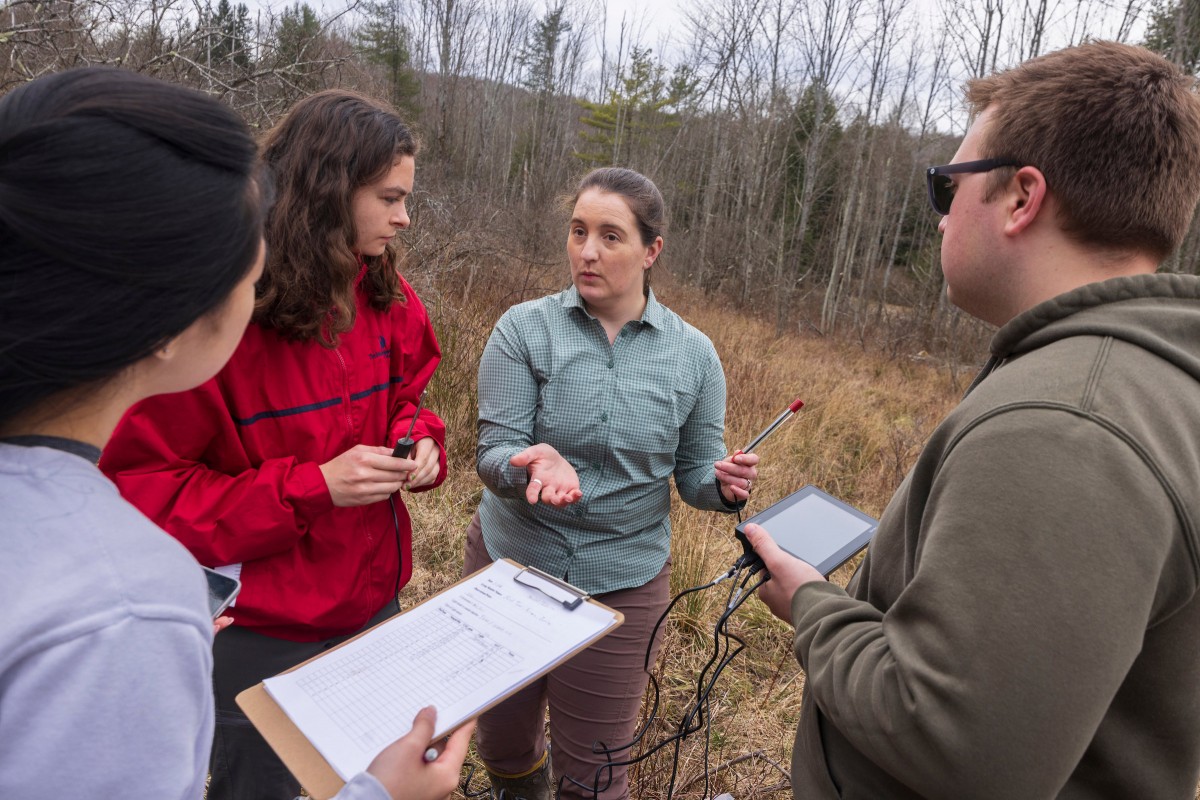Springing into research: The open-air lab of Nuthatch Hollow
Environmental Science students learn hard-science skills in forest, meadow and a whole lot of mud

Early spring is mud season at Nuthatch Hollow, but Assistant Professor of Ecosystem Science Amber Churchill’s students were up to the challenge.
Carrying custom-built cubes and various meters and gauges, research groups slid their way to meadows, slogged through the forest, and swung down from a boardwalk to find a flat pondside spot. That day, ENVI 382B: Measuring the Natural World was tasked with measuring abiotic environmental characteristics — specifically, carbon dioxide concentrations at the ecosystem level, along with light and temperature.
During photosynthesis, plants absorb carbon dioxide from the atmosphere and release oxygen. Green leaves are scarce in the early spring, however, which means that photosynthesis cannot offset the impact of respiration from microbes, animals and plant life.
“The soil is warming up, and we’re starting to see a lot more respiration,” Churchill explained as she handed out worksheets. “That means we’re going to see a lot more CO2, and I’m going to have you quantify the amount of CO2 coming out of the ecosystem.”
The 75-acre nature preserve on Bunn Hill Road offers a wealth of ecosystems to explore: deciduous and coniferous forests, meadows under the powerlines, and riparian areas alongside the pond, where a Canada goose placidly paddled.
It also functions as an open-air lab for classes such as ENVI 382B, which covers abiotic measurements, such as soil moisture and temperature; mobile organisms, including insects and animals; static organisms, such as plants; and community-level data, which includes such factors as forest canopy and ground cover.
During the first part of the semester, the class learned the best practices for conducting natural science research and the intricacies of data management. By the time the season is warm enough for fieldwork, students have already familiarized themselves with data collection and processing, Churchill said.
“Binghamton University has some of the most intelligent and capable professors that I’ve seen at any university that I’ve been to, and I’ve been to several,” said Jared Sackett, a senior environmental studies major, who trekked out to the meadow with his research group. “They’re very intensive about methodology and data tracking methods.”
Sackett appreciates the chance to get out in the field, mud-smeared notes and all. His goal is to become an environmental conservation officer, and the skills he learns in Churchill’s class are immediately relevant to the job, he said.
“Being able to go out and put the methods you learned to the test allows you to form connections, and it allows you to see firsthand a lot of the symbiosis that nature presents,” Sackett said. “It really brings it all together and shows you that you are capable of understanding environmental science, and the things that you are learning in the classroom are conducive to the real world.”
Churchill’s class will apply the research design techniques they learned in the classroom to set up a new experiment in lawn biodiversity on the Jensen Road side of the property. After a contractor finishes clearing the field, ENVI 382B will set up the experiment, which involves plantings of grass, a legume and creeping thyme.
“We’re planting a number of species, and then we’re going to make a whole list of measurements about how having more species influences ecosystem functions in a lawn, such as how green it is, how quickly it covers the ground and how it processes nutrients,” Churchill said. “The idea for this class is to provide students with hard science skills associated with collecting data, processing data, and how we actually go about making measurements under field conditions.”
